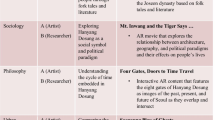Abstract
Building on the concepts of discursive places and relational site-specificity, this chapter analyzes augmented reality (AR) public art and heritage projects that recover lost or repressed narratives and reembed them in material space. Accordingly, these projects enable an expanded sense of place that demonstrates their potential to reframe places as inclusive sites, which emerge from the combination of multiple histories.
Although AR has been used as a surveillance technology in platforms like Pokémon Go, this chapter reconceptualizes AR as a relational technology by recognizing that its output emerges through integrating digital content within material environments. Accordingly, I argue that AR does not simply “augment” reality; rather, AR can be used to (re)program immediate landscapes by facilitating different relationships between virtual content and actual space, which can diversify our experiences of places and cultural narratives.
I demonstrate this by analyzing projects like Border Memorial (2012/2017) and Ward One (2019), which seek to reimagine landscapes in light of the histories of racialized communities. These participatory engagements emphasize how digital technologies produce embodied, multisensorial experiences and a mixed sense of reality. Accordingly, they reimagine sites as discursive and relational places, thus exposing the social constructions embedded in them.
Access this chapter
Tax calculation will be finalised at checkout
Purchases are for personal use only
Similar content being viewed by others
Notes
- 1.
- 2.
The concept of “abstract space” here is in correlation to Henri Lefebvre’s idea (1991). According to Lefebvre, the abstract space is intentionally constructed to distract visitors’ attention from the power dynamics that are embedded and have established cultural spaces.
- 3.
My use of the term “remediation” is borrowed from Jay Bolter and Richard Grusin (2000), who imagine every application of new media as a remediation of an older cultural practice.
- 4.
This collaboration is detailed on the app’s website, http://calliope.cse.sc.edu/wardone/ (retrieved on April 4, 2021).
References
Avram H (2014) Augmented reality. In: Kelly M (ed) Encyclopedia of aesthetics. Oxford University Press, Oxford, pp 232–236
Azuma RT (1997) A survey of augmented reality. Presence Teleoperat Virtual Environ 6(4):355–385
Bolter JD, Grusin R (2000) Remediation: understanding new media. MIT Press, Cambridge, MA
Bolter JD, Macintyre B (2007) Is it live or is it AR? IEEE Spectrum 44(8):30–35
Cooley HR (2019) Politics at the interface: habit-change in the mobile, connected present—the case of ward one app. In: Verhoeff N, Merx S, de Lange M (eds) Urban interfaces: media, art and performance in public spaces. Leonardo Electronic Almanac 22, no. 4
Cooley HR, Buell DA (2018) Building humanities software that matters: the case of the ward one mobile app. In: Sayers J (ed) Making things and drawing boundaries: experiments in the digital humanities. University of Minnesota Press, Minneapolis, London, pp 272–287
Depeña IT (2016) Lapse. http://www.lapsemiami.com/the-sites/. Accessed 28 Dec 2021
Farman J (2013) Mobile interface theory: embodied space and locative media. Routledge
Freeman JC (2012) Border Memorial: Frontera De Los Muertos. https://johncraigfreeman.wordpress.com/border-memorial-frontera-de-los-muertos/. Accessed 28 Dec 2021
Hansen MBN (2006) Bodies in code: interfaces with digital media. Routledge, New York
Hansen MBN (2015) Feed-forward: on the future of twenty-first-century media. University of Chicago Press, Chicago
Kramer J (1992) Whose Art Is It? The New Yorker, December 21
Kwon M (1997) One place after another: notes on site specificity. October 80:85–110
Kwon M (2002) One place after another: site-specific art and locational identity. MIT Press
Lefebvre H (1991 (1974)) The production of space (trans: Donald N-S). Basil Blackwell, Cambridge
Manovich L (2001) The language of new media. MIT Press, Cambridge
Manovich L (2006) The poetics of augmented space. Visual Commun 5(2):219–240
Miami Dade County (2016) Press Releases. https://www.miamidade.gov/releases/2016-06-07-cua-app-lapse-mobile-application.asp. Accessed 28 Dec 2021
Milgram P, Takemura H, Utsumi A, Kishino F (1994) Augmented reality: a class of displays on the reality-virtuality continuum. Paper presented at SPIE [The International Society for Optical Engineering] Proceedings 2351: Telemanipulator and Telepresence Technologies
Ross C (2010) Spatial poetics: the (non)destinations of augmented reality Art, Part I. Afterimage September/October: 19–24
Ulmer GL (2003) Internet invention from literacy to electracy. Longman, New York
Ulmer GL, Freeman JC (2014) Beyond the virtual public square: ubiquitous computing and the new politics of well-being. In: Geroimenko V (ed) Augmented reality art: from an emerging technology to a novel creative medium. Springer, pp 61–79
Wright R (2015) Mobile augmented reality art and the politics of re-assembly. Paper presented at The 21st international symposium on electronic art (ISEA2015)
Zuboff S (2015) Big other: surveillance capitalism and the prospects of an information civilization. J Inf Technol 30(1):75–89
Zuboff S (2019) The age of surveillance capitalism. PublicAffairs, New York
Author information
Authors and Affiliations
Corresponding author
Editor information
Editors and Affiliations
Rights and permissions
Copyright information
© 2022 The Author(s), under exclusive license to Springer Nature Switzerland AG
About this chapter
Cite this chapter
Efrat, L. (2022). Re: Place: Participatory and Discursive Place Making in Augmented Reality (AR) Public Art. In: Rausch, C., Benschop, R., Sitzia, E., van Saaze, V. (eds) Participatory Practices in Art and Cultural Heritage. Studies in Art, Heritage, Law and the Market, vol 5. Springer, Cham. https://doi.org/10.1007/978-3-031-05694-9_8
Download citation
DOI: https://doi.org/10.1007/978-3-031-05694-9_8
Published:
Publisher Name: Springer, Cham
Print ISBN: 978-3-031-05693-2
Online ISBN: 978-3-031-05694-9
eBook Packages: Law and CriminologyLaw and Criminology (R0)




